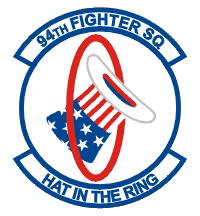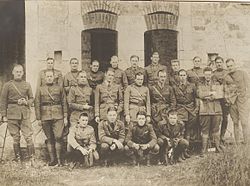94th Fighter Squadron: Difference between revisions
edited introduction |
|||
| Line 1: | Line 1: | ||
{{Infobox Military Unit |
{{Infobox Military Unit |
||
|unit_name= 94th Fighter Squadron |
|unit_name= 94th Fighter Squadron |
||
|image= [[Image:94th Fighter Squadron.png| |
|image= [[Image:94th Fighter Squadron.png|250px]] |
||
|caption= 94th FS Insignia<br>courtesy of www.military-graphics.com |
|caption= 94th FS Insignia<br>courtesy of www.military-graphics.com |
||
|dates= [[August 20]], [[1917]]- |
|dates= [[August 20]], [[1917]]- |
||
| Line 25: | Line 25: | ||
|anniversaries= |
|anniversaries= |
||
}} |
}} |
||
The '''94th Fighter Squadron''' '''(94 FS)''' is a [[United States Air Force]] unit. It is assigned to the [[1st Operations Group]] and stationed at [[Langley Air Force Base]], [[Virginia]]. |
|||
The 94th Fighter Squadron is the second oldest fighter squadron in America's history. |
|||
The '''94th Fighter Squadron''' is a [[squadron]] of the [[United States Air Force]], currently part of the [[1st Operations Group]] of the [[1st Fighter Wing]], and stationed at [[Langley Air Force Base]] in [[Virginia]]. The squadron is newly-equipped with the new [[F-22 Raptor]] fighter jet, having started the transition from the [[F-15]] "Eagle" in [[2005]] to become the USAF's second operational F-22 squadron. |
|||
During [[World War I]], the flight echelon of the '''94th Aero Squadron''', a predecessor [[United States Army Air Service]] designation, was originally composed of former members of the [[French Air Service]] [[Lafayette Escadrille]] (from the French ''Escadrille de [[Gilbert du Motier, marquis de Lafayette|Lafayette]]''). This was a squadron of American volunteer pilots who had joined the French Air Service prior to the United States entry into the war 6 April 1917. |
|||
==Overview== |
|||
Thhe 94 Fighter Squadron is tasked to provide air superiority for the United States and allied forces by engaging and destroying enemy forces, equipment, defenses or installations for global deployment as part of the 1st Fighter Wing. |
|||
The 94th flies today's advanced air dominance fighter, the [[F-22A Raptor]], being the USAF's second operational F-22 squadron in 2005. 94 FS aircraft are identified by the tail code "FF" and a blue tail flash. |
|||
==History== |
==History== |
||
Revision as of 22:55, 24 May 2009
| 94th Fighter Squadron | |
|---|---|
 94th FS Insignia courtesy of www.military-graphics.com | |
| Active | August 20, 1917- |
| Country | United States |
| Branch | United States Air Force |
| Role | Fighter |
| Part of | 1st Operations Group 1st Fighter Wing |
| Garrison/HQ | Langley Air Force Base |
| Motto(s) | "Hat in the Ring" |
| Engagements | World War I World War II Cuban Missile Crisis Operation Northern Watch Operation Southern Watch |
| Commanders | |
| Notable commanders | Paul V. Hester Earle E. Partridge Ennis Whitehead |
The 94th Fighter Squadron (94 FS) is a United States Air Force unit. It is assigned to the 1st Operations Group and stationed at Langley Air Force Base, Virginia.
The 94th Fighter Squadron is the second oldest fighter squadron in America's history.
During World War I, the flight echelon of the 94th Aero Squadron, a predecessor United States Army Air Service designation, was originally composed of former members of the French Air Service Lafayette Escadrille (from the French Escadrille de Lafayette). This was a squadron of American volunteer pilots who had joined the French Air Service prior to the United States entry into the war 6 April 1917.
Overview
Thhe 94 Fighter Squadron is tasked to provide air superiority for the United States and allied forces by engaging and destroying enemy forces, equipment, defenses or installations for global deployment as part of the 1st Fighter Wing.
The 94th flies today's advanced air dominance fighter, the F-22A Raptor, being the USAF's second operational F-22 squadron in 2005. 94 FS aircraft are identified by the tail code "FF" and a blue tail flash.
History
The 94th Fighter Squadron has a long history and traditions that date back to World War I. The squadron was officially activated at Kelly Field, Texas, on 20 August 1917, as the 94th Aero Squadron.
World War I

On September 30 1917, two officers and 150 enlisted men left Texas for France and were sent to seven different aircraft factories for maintenance and repair training. In April 1918, the 94th was reunited and stationed at the Gengault Aerodrome near Toul, France, where it began operations as the first American squadron at the front.
As the first American squadron in operation, its aviators were allowed to create their squadron insignia. They used the opportunity to commemorate the United States' entry into World War I by taking the phrase of tossing one's "hat in the ring" (a boxing phrase to signify one's willingness to become a challenger) and symbolizing it with the literal image of Uncle Sam's red, white and blue top hat going through a ring.
On April 14, Lt. Douglas Campbell, who later became America's first flying ace, and Lt. Alan Winslow downed two German aircraft. These were the first victories ever scored by an American unit. No 94th pilot achieved more aerial victories than 1st Lt. Edward Vernon Rickenbacker, who was named America's "Ace of Aces" during the war. In his Nieuport 28 and later in his SPAD S.XIII, Rickenbacker was credited with 26 of the squadron's 70 kills during World War I. By the end of hostilities, the 94th had won battle honors for participation in 11 major engagements and was awarded the Croix de Guerre with Palm.
During World War I, The squadron was based at Toul (May 5, 1918), Touquin (June 28, 1918), Saints (July 9, 1918) and Rembercourt (September 1, 1918).
Another flying ace of this squadron was Harvey Weir Cook.
The squadron returned home in the spring of 1919, and after several moves, the 94th settled at Selfridge Field, Michigan, in July 1922. In 1923, the unit was re-designated the 94th Pursuit Squadron. The squadron stayed in Michigan for the remainder of the inter-war years, training in its pursuit role. The squadron flew 17 different aircraft during this period, culminating with the P-38 Lightning. One week after Pearl Harbor, the 94th moved to San Diego Naval Air Station. Expecting to see action in the Pacific, the squadron instead received orders for Europe. In the summer of 1942, the 94th deployed under its own power to England, the U.K., via Canada, Labrador, Greenland, and Iceland. This marked the first time that a fighter squadron flew its own aircraft from the United States to Europe.
World War II
In November 1942, as part of the newly re-designated 1st Fighter Group, the 94th Fighter Squadron went into combat in North Africa. Based in Algeria, Tunisia, and Italy, the 94th again distinguished itself in combat by winning two Presidential Distinguished Unit Citations as part of the 1st Group. In addition, the squadron earned 14 Campaign honors, participating in almost every campaign in North Africa and Europe. 64 pilots of the 94th Fighter Squadron were credited with 124 Axis aircraft destroyed. The 94th produced a total of six aces in World War II. In April 1945 the 1st Fighter Group received two YP-80 jets for operational testing. The 94th Squadron's Major Edward LaClare flew two operational sorties in the YP-80 although without encountering combat.
The Cold War
After the war, the 94th trained in the Lockheed P-80 Shooting Star, America's first operational jet fighter, and was stationed at March AFB, California. In July 1950, the group became the 94th Fighter Intercept Squadron (FIS) and was eventually assigned to Air Defense Command (ADC). After the P-80, the squadron flew several aircraft in the interceptor role, including the F-86, F-102 and F-106. In 1956, the 94th won the Worldwide Rocket Firing Meet held at Vincent AFB, Arizona. In the 1960s, the unit was among the first ready units sent to Florida during the Cuban Missile Crisis in October 1962. The squadron carried out combat patrol missions off the coast of Florida, setting a record for F-106 hours and sorties. During the 1960s, the 94th, along with other ADC units, maintained an alert force in Alaska.
With its supersonic F-106s, the squadron intercepted Russian bombers on missions over the Bering Sea. Then, in June 1969, with tensions mounting following the Pueblo Incident and the downing of an EC-121 electronic observation plane by North Korea, the squadron deployed to Osan AB, South Korea, for six months. On 1 July 1971, the 94th moved back to the USA, to MacDill AFB, Florida, as part of a realignment of the original First Pursuit Group. The squadron was designated the 94th Tactical Fighter Squadron, reassigned to Tactical Air Command, and reunited with the 27th and 71st Squadrons under the 1st Tactical Fighter Wing (TFW), flying the F-4E. The 94th assumed the duties of a Replacement Training Unit (RTU), providing F-4 aircrews for operational combat squadrons.
In 1975, the 1st TFW moved to Langley AFB, Virginia, and began flying the F-15 Eagle. The squadron became combat-ready in early 1977. In September 1992, the squadron was renamed the 94th Fighter Squadron.
The 94th Fighter Squadron did not deploy to Southwest Asia for the first Persian Gulf War, although many of its pilots and maintenance personnel did as augmenters to both the 71st and 27th Fighter Squadrons from the 1st Fighter Wing. The 94th successfully supported the UN-sanctioned Operation Southern Watch and Operation Northern Watch in Iraq with many deployments to Saudi Arabia and Turkey in the period leading up to the Iraq War. The 94th Fighter Squadron pilots repeatedly defeated Iraqi surface-to-air missiles (SAMs) and anti-aircraft artillery (AAA) attacks while enforcing UN sanctions, without loss or damage to a single aircraft.
Since the September 11 attacks on the United States, the aircraft of the 94th have patrolled the skies of the East Coast of the United States.
The F-22 Era
In 2006, the 94th became only the second operational squadron to fly the F-22 Raptor, receiving its first F-22 in June 2006, and receiving its full complement of F-22s, with tail number 05-094, in June 2007. This was due to the 94th FS trading tail number 086 for 094 with the 90th Fighter Squadron, which is part of the 3rd Wing based at Elmendorf AFB, Alaska. [1]
Additionally, the 1st FW traded tail 05-084 to the 90th Fighter Squadron for tail 05-101. Tail 05-101 is the current 1st Fighter Wing flagship and flies as part of the 94th Fighter Squadron.
Trivia
A popular restaurant chain, the 94th Aero Squadron, is named after the 94th from the First World War.
References
Notes
Bibliography
- Guttman, Jon. USAS 1st Pursuit Group. Botley, Oxford, UK: Osprey Publishing Ltd., 2008. ISBN 1-84603-309-4.
- Woolley, Charles. The Hat in the Ring Gang: The Combat History of the 94th Aero Squadron in World War I. Atglen, Pennsylvania: Schiffer Publishing, . ISBN 0-76431-427-0.
